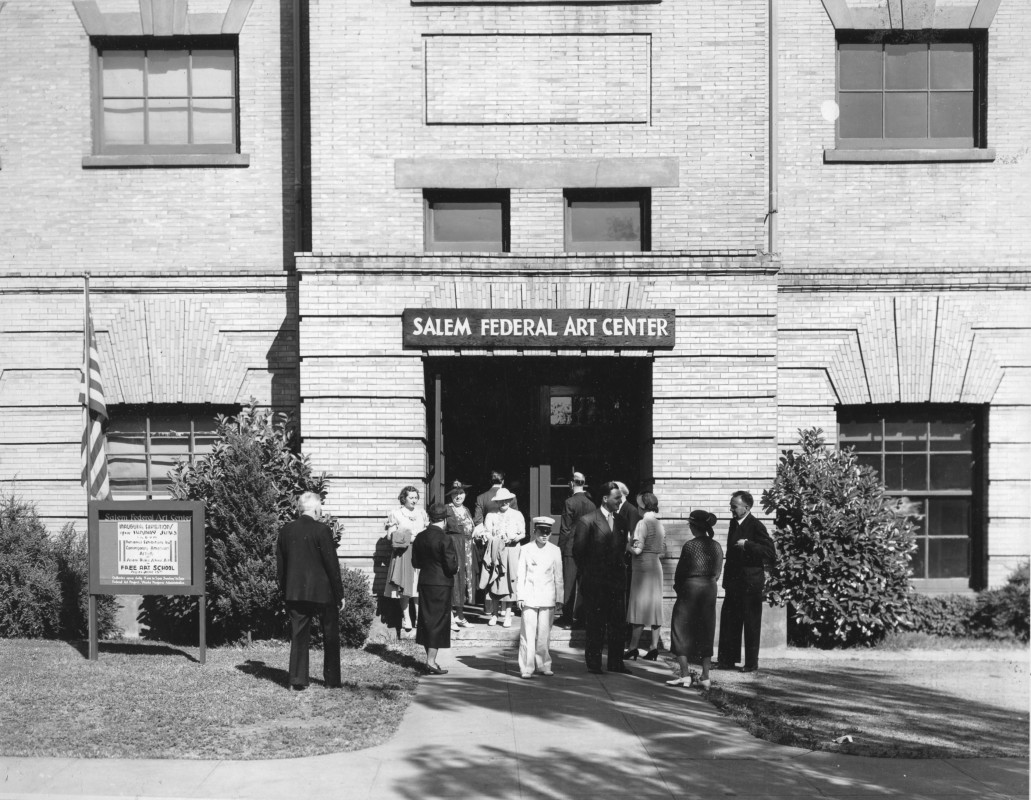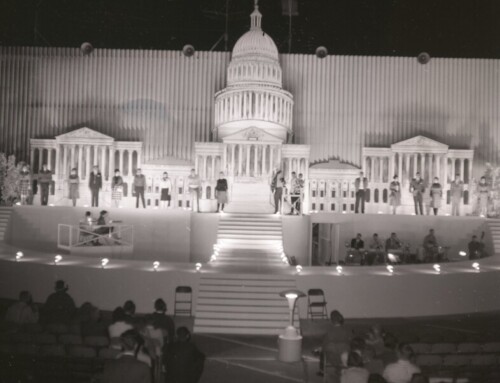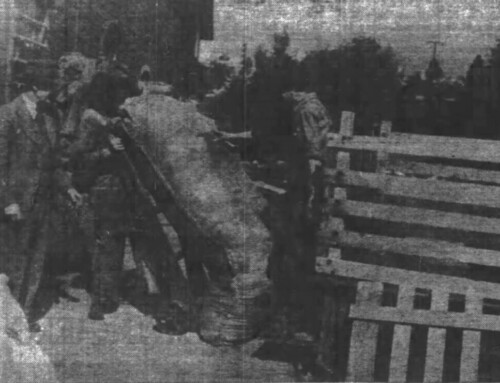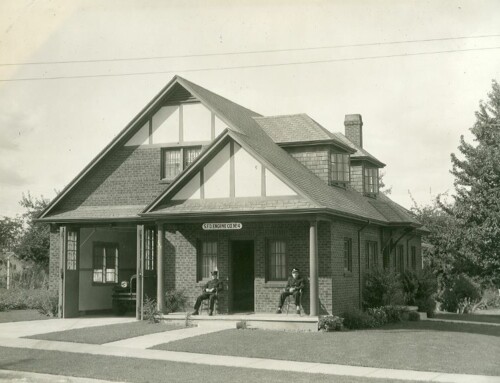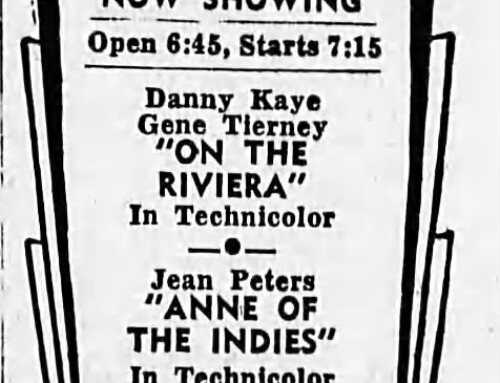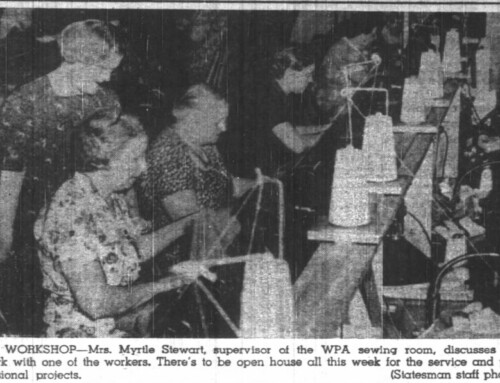An opportunity arose this past month, with a change in Salem Fiberarts Guild leadership, to examine and document the history of the guild. For those unfamiliar with the group, the Salem Fiberarts Guild occupies the 4th floor of the Thomas Kay Woolen Mill at the Willamette Heritage Center and provides weekly demonstrations and ongoing textile art classes. A file box packed full of photographs, newspaper clippings and institutional records was shared with the WHC curatorial team and as we organized and began the cataloging process, we found a number of references to a Federal Art Center in Salem. We were intrigued and with a little research we discovered a great community story about the importance and preservation of the arts.
The story began with a meeting in November of 1937 between representatives of the Federal Art Project and a group of prominent Salem citizens and newspapermen. Offered under the Works Progress Administration, the Federal Art Project (FAP) was a unique partnership between the federal government and local communities, to bring the arts into public life. Salem had been identified as a prime location for a community-based art center. Just to give you an idea of scale, by December of 1937, 50 community art centers were in operation across the United States. By 1940, there were 84.
Local response was enthusiastic despite the depressed economy of the Great Depression. Salem residents embraced the opportunity and challenge to become the home of Oregon’s first Federal Art Center. Holger Cahill, director of the FAP authorized $12,000 a year in assistance if the community would raise an additional $2000. FAP funding would provide for staff salaries, equipment and supplies while the local community funded operating costs and provided a building.
Senator Douglas McKay and Charles Sprague, owner of the Daily Statesman were appointed co-chairmen of an exploratory committee. Beginning January 1938, the committee launched a public relations campaign to organize informational meetings with local citizens groups and initiate fundraising efforts. Response from Salem’s citizens was immediate. Every school in Salem participated by holding benefits for the center and school children were encouraged to donate their pennies to the campaign. Other civic clubs and organizations also stepped in with fundraising events of their own, and a community-wide Beaux Arts Ball was held in February. Private donors included leading citizens such as the governor and secretary of state. Within a few months, the committee had raised $2600, exceeding their target amount.
With the required community funds in hand, Salem then formed a sponsoring committee for the Art Center. The president was Mrs. Vernon Douglas, wife of the county health physician, first vice-president was attorney Otto K. Paulus and the second vice-president was Mrs. J. M. Devers. The secretary was Mr. Edward Acklin, shoe dealer and the treasurer Mr. Tinkham Gilbert, of Ladd and Bush Bank. First matter at hand was the selection of a building. The committee chose to retrofit the old high school at 460 North High Street, a location that would provide ample space for three studio rooms, three galleries, an office and workroom. Then began the search for a director. With the help of FAP director Holger Cahill they settled on Charles Val Clear the director of the Art League in Washington D.C. He arrived in Salem April 1938.
Work was completed on the building in time for the opening on June 5, 1938 and Mayor Kuhn declared June 4-11 Art Week in order to celebrate its opening. One thousand people attended the opening and 328 of them signed up for the center’s first round of free art classes, forcing them to close registration. The center initially offered classes for all ages in easel painting, sculpture, mural painting and graphics. Later offerings included music, theater, and heritage crafts such as weaving. For the most part class offerings were tailored toward amateurs, but studio space was also reserved for more advanced students. There was no charge for instruction, but students purchased their own materials. The Art Center also hosted a changing schedule of exhibits that balanced artwork of national significance with work done by local students.
Two additional art centers would be created in Oregon, one at Gold Beach and another in La Grande. And discussions had begun toward creating art centers in Klamath Falls and Medford in the 1940s. But by the spring of 1942 FAP funding began to run out as the nation’s focus shifted toward the war effort. Many FAP programs were also redirected toward military tasks such as the creation of recruiting posters. By June 1942 all FAP money had been diverted and all art centers had lost federal support. Oregon’s three centers continued to run for some months with private support, but all were eventually forced to close. Salem’s building became the new home for school district offices.
Though relatively short-lived, the Salem Federal Art Center and others around the nation left their imprint on the communities in which they were built. The fundraising, organization and running of the centers united communities as they worked to support a single cause, a skill that would prove valuable in the following war years. Thousands of adults and children were exposed to art and given the opportunity to develop and expand artistic interests. And a revival of heritage skills such as weaving was experienced.
Today, the Salem Fiberarts Guild continues to support and preserve the art of weaving and other textile arts through their partnership with the Willamette Heritage Center. Families are invited to attend their Annual Handweaver’s Sale October 4-5th in the Dye House at the Willamette Heritage Center. Demonstrations will take place throughout both days in weaving, spinning, rug hooking, lace making and other fiber arts, and one-of-a-kind gifts created by artisans of the guild will be available for purchase. Admission is free.
This article was written by Kaylyn F. Mabey for the Statesman Journal where it was printed 15 September 2019. It is reproduced here with sources for reference purposes.
Sources:
- CultureWork – A Periodic Broadside for Arts and Culture, March 2003, Vol. 7, No. 2, University of Oregon publication
- Oregon Federal Art Project 1935-1943, Multnomah County Library Website https://gallery.multcolib.org/collection/oregon-federal-art-project-1935-1943
- “Federal Art Center in Salem” Oregon Statesman, 26 Aug 1937, p. 1
- “Federal Art Center is Favored Here; Program Launched by Committee” Oregon Statesman, 2 Dec 1937, p. 1
- “Federal Art Center Near Finance Goal” Capital Journal, 5 Mar 1938, p. 5
- “Chamber Endorses New Art Center” Capital Journal, 21 Jan 1938, p. 3



